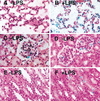Lipopolysaccharide induction of tissue factor expression in rabbits
- PMID: 10225918
- PMCID: PMC116001
- DOI: 10.1128/IAI.67.5.2540-2546.1999
Lipopolysaccharide induction of tissue factor expression in rabbits
Abstract
Tissue factor (TF) is the major activator of the coagulation protease cascade and contributes to lethality in sepsis. Despite several studies analyzing TF expression in animal models of endotoxemia, there remains debate about the cell types that are induced to express TF in different tissues. In this study, we performed a detailed analysis of the induction of TF mRNA and protein expression in two rabbit models of endotoxemia to better understand the cell types that may contribute to local fibrin deposition and disseminated intravascular coagulation. Northern blot analysis demonstrated that lipopolysaccharide (LPS) increased TF expression in the brain, lung, and kidney. In situ hybridization showed that TF mRNA expression was increased in cells identified morphologically as epithelial cells in the lung and as astrocytes in the brain. In the kidney, in situ hybridization experiments and immunohistochemical analysis showed that TF mRNA and protein expression was increased in renal glomeruli and induced in tubular epithelium. Dual staining for TF and vWF failed to demonstrate TF expression in endothelial cells in LPS-treated animals. These results demonstrate that TF expression is induced in many different cell types in LPS-treated rabbits, which may contribute to local fibrin deposition and tissue injury during endotoxemia.
Figures







References
-
- Andrews B S, Rehemtulla A, Fowler B J, Edgington T S, Mackman N. Conservation of tissue factor primary sequence among three mammalian species. Gene. 1991;98:265–269. - PubMed
-
- Bach R R. Initiation of coagulation by tissue factor. Crit Rev Biochem. 1988;23:339–368. - PubMed
-
- Broze G J, Leyham J E, Schwartz B D, Miletich J P. Purification of human brain tissue factor. J Biol Chem. 1985;260:10917–10920. - PubMed
-
- Brukman J, Wiggins R C. Procoagulant activity in kidneys of normal and bacterial lipopolysaccharide-treated rabbits. Kidney Int. 1987;32:31–38. - PubMed
-
- Chomczynski P, Sacchi N. Single-step method of RNA isolation by acid guanidinium thiocyanate-phenol-chloroform extraction. Anal Biochem. 1987;162:156–159. - PubMed
Publication types
MeSH terms
Substances
Grants and funding
LinkOut - more resources
Full Text Sources
Miscellaneous

